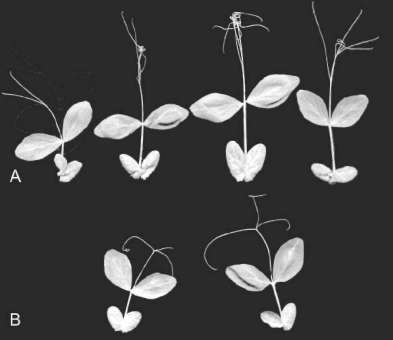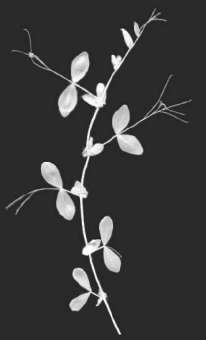Pisum Genetics 2006—Volume 38 Research Papers


Fig. 1. (left) SGE-0274 plant. Fig. 2 (right) Leaves of the SGE-0274 mutant (A) and the leaves of the parental line SGE (B).
intersect the primary rachis at an angle of about 20 to 45 degrees, while the parent line SGE forms lateral tendril branches at a nearly right angle (Fig. 2).
As far as I know, a similar phenotype has not been described before. I suggest that a new, previously unknown locus is involved in SGE-0274 tendril formation. SGE-0274 tendrils never form a compact glomerule such as is characteristic of Twt plants; moreover, Twt is a dominant gene. The only known gene that forces lateral tendrils to grow at the angle less then 90 degrees is af. However, the allelic test of SGE-0274 and WL-1746 line (af) suggest that they are not allelic: all F1 plants were of normal phenotype — no afila, and lateral tendrils were arranged at the right angle.
The SGE-0274 mutant phenotype was designated as the tendrils at acute angle, and I propose the gene symbol taa for it.
Acknowledgement: The author gratefully acknowledges Vera S. Bogdanova for her discussion of this work and support in preparing the publication.
1. Gorel, F.L., Temnykh, S.V., Lebedeva, I.P. and Berdnikov, V.A. 1992. Pisum Genetics 24: 48-49.
2. Berdnikov V.A., Gorel F.L. and Temnykh S.V. 1994. Pisum Genetics 26: 9-10.
3. Sharma, B. 1973. PNL 5: 46.
4. Blixt S. 1972. Agri Hortique Genetica 30: 1–293.
5. Pisum Genetics Association Gene List. Pgene, http://www.jic.ac.uk/GERMPLAS/pisum/Zgc4g.htm
31